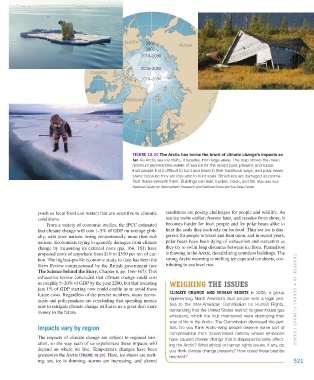Page 522 - Environment: The Science Behind the Stories
P. 522
ALASKA 2000 RUSSIA
2002
2010–2030
2040–2060
CANADA
2070–2090
GREENLAND
ICELAND
FINLAND
NORWAY
SWEDEN
Figure 18.20 The Arctic has borne the brunt of climate change’s impacts so
far. As Arctic sea ice melts, it recedes from large areas. The map shows the mean
minimum summertime extent of sea ice for the recent past, present, and future.
Inuit people find it difficult to hunt and travel in their traditional ways, and polar bears
starve because they are less able to hunt seals. Structures are damaged as perma-
frost thaws beneath them: Buildings can lean, buckle, crack, and fall. Map data from
National Center for Atmospheric Research and National Snow and Ice Data Center.
(such as local food and water) that are sensitive to climatic conditions are posing challenges for people and wildlife. As
conditions. sea ice melts earlier, freezes later, and recedes from shore, it
From a variety of economic studies, the IPCC estimated becomes harder for Inuit people and for polar bears alike to
that climate change will cost 1–5% of GDP on average glob- hunt the seals they each rely on for food. Thin sea ice is dan-
ally, with poor nations losing proportionally more than rich gerous for people to travel and hunt upon, and in recent years,
nations. Economists trying to quantify damages from climate polar bears have been dying of exhaustion and starvation as
change by measuring its external costs (pp. 164, 183) have they try to swim long distances between ice floes. Permafrost
proposed costs of anywhere from $10 to $350 per ton of car- is thawing in the Arctic, destabilizing countless buildings. The
bon. The highest-profile economic study to date has been the strong Arctic warming is melting ice caps and ice sheets, con-
Stern Review commissioned by the British government (see tributing to sea level rise.
The Science behind the Story, Chapter 6, pp. 166–167). This
exhaustive review concluded that climate change could cost
us roughly 5–20% of GDP by the year 2200, but that investing WEIGHING THE ISSUES
just 1% of GDP starting now could enable us to avoid these
future costs. Regardless of the precise numbers, many econo- CLIMATE CHANGE AND HUMAN RIGHTS In 2005, a group
mists and policymakers are concluding that spending money representing North America’s Inuit people sent a legal peti- CHAPTER 18 • Glob al Cli M aT e Chan G e
now to mitigate climate change will save us a great deal more tion to the Inter-American Commission on Human Rights,
money in the future. demanding that the United States restrict its greenhouse gas
emissions, which the Inuit maintained were destroying their
way of life in the Arctic. The Commission dismissed the peti-
Impacts vary by region tion. Do you think Arctic-living people deserve some sort of
compensation from industrialized nations whose emissions
The impacts of climate change are subject to regional vari- have caused climate change that is disproportionately affect-
ation, so the way each of us experiences these impacts will ing the Arctic? What ethical or human rights issues, if any, do
depend on where we live. Temperature changes have been you think climate change presents? How could these best be
greatest in the Arctic (Figure 18.20). Here, ice sheets are melt- resolved?
ing, sea ice is thinning, storms are increasing, and altered 521
M18_WITH7428_05_SE_C18.indd 521 12/12/14 4:05 PM

